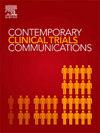北卡罗莱纳州乳腺癌和结肠癌幸存者身体活动指数(PAI)可行性试点试验的研究设计和方法
IF 1.4
Q4 MEDICINE, RESEARCH & EXPERIMENTAL
引用次数: 0
摘要
在1800万有癌症病史的美国成年人(“幸存者”)中,大多数人在日常生活中没有达到定期体育锻炼(PA)或限制久坐行为的建议。乳腺癌幸存者(BCS)和结肠癌幸存者(CCS)尤其面临PA不足和过度久坐行为(即久坐)的风险,这可能会增加身体损伤,恶化癌症治疗症状,限制最佳癌症恢复,并限制潜在降低癌症风险的机会。研究表明,完成临床癌症治疗可能会成为患者在家中过渡到康复的“教育时刻”。如果没有医疗团队的指导,这些幸存者中的许多人都不确定是否能建立一个更健康的生活方式,但很少有有效的临床工具来评估和咨询幸存者与PA和久坐行为相关的行为选择。根据我们最近的发现,一个简单的筛选器收集了PA、力量训练和久坐行为的测量,即身体活动指数(PAI),可能有效地用于临床监测患者的行为,并就如何实现和维持行为目标提供具体的、量身定制的建议。我们提出了一项多成分、双臂1:1随机对照试验,其中我们将招募(n = 20)诊断为三年内的BCS和CCS患者,以利用早期康复的“可教时刻”。PAI干预将包括标准的生存随访护理,使用提供给提供者的PAI筛选器进行PA评估,以及与认证运动生理学家进行的五次远程指导咨询。所有参与者还将获得一个随身携带的阻力带和一个活动追踪器,以便在家中自我监控他们的行为。我们将通过检查招募、保留、可接受性和PAI干预依从性目标来确定可行性。其次,我们将测量PA和久坐行为的行为结果实现的变化/可变性,以告知未来的试验计划。本文章由计算机程序翻译,如有差异,请以英文原文为准。
Study design and methods for the physical activity index (PAI) feasibility pilot trial for breast and colon cancer survivors in North Carolina
The majority of the 18 million US adults with cancer history (“survivors”) do not meet recommendations for obtaining regular physical activity (PA) or limiting sedentary behavior in their daily lives. Breast cancer survivors (BCS) and colon cancer survivors (CCS) are particularly at risk of insufficient PA and excessive sedentary behavior (i.e., sitting) that may increase physical impairments, worsen cancer treatment symptoms, limit optimal cancer recovery, and limit opportunities to potentially reduce cancer risk. Research has shown that completion of clinical cancer treatment may serve as a ‘teachable moment’ for patients as they transition to recovery at home. Many of these survivors are uncertain about building a healthier lifestyle without guidance from the medical team, but few validated clinical tools exist to assess and counsel survivors on their behavioral choices relative to PA and sedentary behavior.
Based on our recent findings, a simple screener that collects measures on PA, strength training, and sedentary behavior, the Physical Activity Index (PAI), may be effective for clinical use to monitor patient behaviors and provide specific, tailored recommendations on how to achieve and maintain behavioral goals. We propose a multicomponent, two-arm pilot 1:1 randomized controlled trial with waitlist control in which we will recruit (n = 20) BCS and CCS within three years of diagnosis to leverage the ‘teachable moment’ in early recovery. The PAI intervention will include standard survivorship follow-up care plus a PA assessment using the PAI screener that is supplied to the provider plus five remote coaching consultations with a certified exercise physiologist. All participants will also receive resistance bands to keep and an activity tracker to self-monitor their behaviors at home.
We will determine feasibility by examining recruitment, retention, acceptability, and PAI intervention adherence goals. Secondarily, we will measure changes/variability in achievement of behavioral outcomes for PA and sedentary behaviors to inform future trial planning.
求助全文
通过发布文献求助,成功后即可免费获取论文全文。
去求助
来源期刊

Contemporary Clinical Trials Communications
Pharmacology, Toxicology and Pharmaceutics-Pharmacology
CiteScore
2.70
自引率
6.70%
发文量
146
审稿时长
20 weeks
期刊介绍:
Contemporary Clinical Trials Communications is an international peer reviewed open access journal that publishes articles pertaining to all aspects of clinical trials, including, but not limited to, design, conduct, analysis, regulation and ethics. Manuscripts submitted should appeal to a readership drawn from a wide range of disciplines including medicine, life science, pharmaceutical science, biostatistics, epidemiology, computer science, management science, behavioral science, and bioethics. Contemporary Clinical Trials Communications is unique in that it is outside the confines of disease specifications, and it strives to increase the transparency of medical research and reduce publication bias by publishing scientifically valid original research findings irrespective of their perceived importance, significance or impact. Both randomized and non-randomized trials are within the scope of the Journal. Some common topics include trial design rationale and methods, operational methodologies and challenges, and positive and negative trial results. In addition to original research, the Journal also welcomes other types of communications including, but are not limited to, methodology reviews, perspectives and discussions. Through timely dissemination of advances in clinical trials, the goal of Contemporary Clinical Trials Communications is to serve as a platform to enhance the communication and collaboration within the global clinical trials community that ultimately advances this field of research for the benefit of patients.
 求助内容:
求助内容: 应助结果提醒方式:
应助结果提醒方式:


